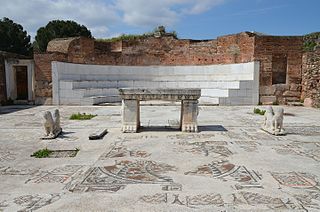
The menorah is a seven-branched candelabrum that is described in the Hebrew Bible and in later ancient sources as having been used in the Tabernacle and in the Temple in Jerusalem.

The Arch of Titus is a 1st-century AD honorific arch, located on the Via Sacra, Rome, just to the south-east of the Roman Forum. It was constructed in c. AD 81 by Emperor Domitian shortly after the death of his older brother Titus to commemorate Titus's official deification or consecratio and the victory of Titus together with their father, Vespasian, over the Jewish rebellion in Judaea.

The First Jewish–Roman War, sometimes called the Great Jewish Revolt, or The Jewish War, was the first of three major rebellions by the Jews against the Roman Empire fought in Roman-controlled Judea, resulting in the destruction of Jewish towns, the displacement of its people and the appropriation of land for Roman military use, as well as the destruction of the Jewish Temple and polity.
Jewish studies is an academic discipline centered on the study of Jews and Judaism. Jewish studies is interdisciplinary and combines aspects of history, Middle Eastern studies, Asian studies, Oriental studies, religious studies, archeology, sociology, languages, political science, area studies, women's studies, and ethnic studies. Jewish studies as a distinct field is mainly present at colleges and universities in North America.

The Herbert D. Katz Center for Advanced Judaic Studies at the University of Pennsylvania—commonly called the Katz Center—is a postdoctoral research center devoted to the study of Jewish history and civilization.

The siege of Jerusalem of 70 CE was the decisive event of the First Jewish–Roman War, in which the Roman army led by future emperor Titus besieged Jerusalem, the center of Jewish rebel resistance in the Roman province of Judaea. Following a five-month siege, the Romans destroyed the city and the Second Jewish Temple.
Lawrence Harvey Schiffman is a professor at New York University ; he was formerly Vice-Provost of Undergraduate Education at Yeshiva University and Professor of Jewish Studies. He had previously been Chair of New York University's Skirball Department of Hebrew and Judaic Studies and served as the Ethel and Irvin A. Edelman Professor in Hebrew and Judaic Studies at New York University (NYU). He is currently the Judge Abraham Lieberman Professor of Hebrew and Judaic Studies at New York University and Director of the Global Institute for Advanced Research in Jewish Studies. He is a specialist in the Dead Sea Scrolls, Judaism in Late Antiquity, the history of Jewish law, and Talmudic literature.
Lee I. Levine is an American-born Israeli rabbi, archaeologist and historian of classical Judaism. He is a strong believer in the ability of the Jewish people and Judaism to adapt to local settings as a key to survival. He is the author of Judaism and Hellenism in Antiquity and The Ancient Synagogue, one of the most comprehensive texts on the subject.

Ze’ev Raban (22 September 1890 – 19 January 1970), born Wolf Rawicki (Ravitzki), was a leading painter, decorative artist, and industrial designer of the Bezalel school style, and was one of the founders of the Israeli art world.

Kfar Baram synagogue, also Kafar Berem synagogue, is the ruins of two ancient Jewish synagogues at the site of Kafr Bir'im, a depopulated Palestinian village which in medieval times was the Jewish village of Kfar Bar'am. Today, it is located in Northern Israel, 3 kilometers from the Lebanese border.

God-fearers or God-worshippers were a numerous class of Gentile sympathizers to Hellenistic Judaism that existed in the Greco-Roman world, which observed certain Jewish religious rites and traditions without becoming full converts to Judaism. The concept has precedents in the proselytes of the Hebrew Bible.
The Yeshiva University Center for Israel Studies reflects the longstanding relationship between Yeshiva University and Israel. It supports research, conferences, publications, museum exhibitions, public programs and educational opportunities that enhance awareness and study of Israel in all of its complexities. The center is led by Director Steven Fine, Professor of Jewish History at Yeshiva University, and Associate Director Joshua Karlip, Professor of Jewish History at Yeshiva University.
Beth Alpha is a sixth-century CE synagogue located at the foot of the northern slopes of the Gilboa mountains near Beit She'an, Israel. It is now part of Bet Alfa Synagogue National Park and managed by the Israel Nature and Parks Authority.

The Henry S. Frank Memorial Synagogue, commonly called the Frank Memorial Synagogue, is an historical Jewish synagogue, located on the grounds of Jefferson Einstein Hospital, in Philadelphia, Pennsylvania, in the United States. The synagogue was funded substantially by Rose S. Frank and named in honor of her late husband, Henry S. Frank, a philanthropist who died in 1887.

The Nabratein synagogue is an ancient synagogue and archaeological site in the Upper Galilee region of the Northern District of Israel, located in a pine forest northeast of Safed.

Yaacov Ben-Dov was an Israeli photographer and a pioneer of Jewish cinematography in Palestine.

Tzippori Synagogue is an ancient synagogue discovered in Sepphoris, a Roman-era Jewish city in the Galilee, now an archaeological site and a national park in Israel.

Hammath Tiberias or Hammat Tiberias is an ancient archaeological site and an Israeli national park known as Hamat Tverya National Park, which is located on the adjacent to Tiberias on the road to Zemach that runs along the shore of the Sea of Galilee.

The Magdala stone is a carved stone block unearthed by archaeologists in the Migdal Synagogue in Israel, dating to before the destruction of the Second Temple in Jerusalem in the year 70.

Ancient Jewish art, is art created by Jews in both the Land of Israel and in the Diaspora prior to the Middle Ages. It features symbolic or figurative motifs often influenced by biblical themes, religious symbols, and the dominant cultures of the time, including Egyptian, Hellenistic, and Roman art.















